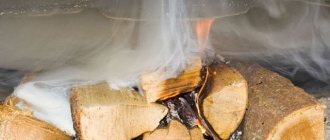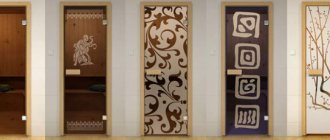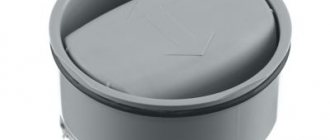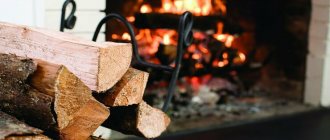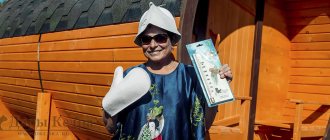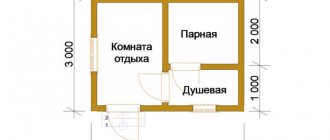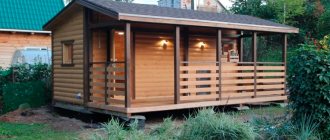A Finnish bathhouse is called a sauna, which, in fact, is very similar to a Russian one, and it also contains a wood-burning stove.
Wood burning stove for a large sauna
Having achieved good heat in the firebox and good heating of the stones, cold water is splashed on them and dry steam is obtained, which gives a pleasant aroma to the steam room. Sometimes decoctions of fragrant herbs or essential oils are used to create steam; in this case, the bathhouse is filled with healing air and helps to cope with many diseases.
How they work and how they are installed is a must-know to ensure their safe and easy operation.
It is believed that Russian and Finnish baths promote relaxation and increase vitality, heal mental wounds, and are also a place where you can hide from what spoils your mood. But if you decide to visit the sauna for the first time, it would be a good idea to consult a doctor so that the bath will only bring benefits and not harm your health. The heat coming from the heater, which maintains the room temperature at 75-120 degrees, can negatively affect the condition of hypertensive patients and people with heart disease.
Traditional Finnish saunas include six rooms: a waiting room, a locker room, a shower, a steam room, a swimming pool and a relaxation room, where green tea must be present.
Today, they usually make do with two, or at most three, rooms - a locker room, also known as a furnace room, a steam room and a shower room. A sauna stove is usually installed in the wall between the dressing room and the steam room, so that it is possible to add firewood from another room, this is very convenient and functional, we advise you to do just that!
Principle of operation
And the operation of these devices is no different from their analogues. The oven consists of several main parts:
- furnace body;
- separate compartment for burning wood;
- an ash pan, which is located in the lower part of the stove and serves to collect ash and as a blower to increase draft during the initial ignition of wood;
- grate. It is installed above the ash pan and serves to protect the furnace body from exposure to high temperatures and unhindered pouring of ash into a container for collecting it;
- a screen that is installed in some models and is designed to prevent the direct passage of heat into the chimney. Heat is reflected from the screen, passes through the inside of the stove and only then enters the upper compartment and passes to the chimney, heating the stones;
- exhaust gases exit into the chimney pipe and are released into the atmosphere;
- On top of the furnace body there is a grid for laying stones. When wood burns, the stones heat up. Anyone can raise the temperature in the steam room by splashing several ladlefuls of aromatic infusion or water on the heater.
Review of the best models
| Model name | Description | Advantages | Price |
| Russian mini-stove “Anyutka” | Installed for servicing premises with a volume of up to 10 m3. Made from mild structural steel. Equipped with a convection casing, which ensures uniform and fast heating of the steam room. With minimal dimensions, it can accommodate 25 kg of stones in the compartment | The minimum dimensions allow installation anywhere in a small steam room. Provides comfortable conditions. The design is reliable and easy to maintain. The chimney is located in the center of the stove. | Average price 8000 rub. |
| Mini-heater “Sudarushka MK” | Made in Russia. Provides comfort in a steam room up to 18 m3. One year warranty. Dimensions: · height -95.7 cm; · width – 59.5 cm; · depth – 96.5 cm. Made of cast iron. Weight 140 kg. | Up to 100 kg of stones can be placed in the net. This allows you to additionally accumulate heat and heat the steam room for a long time with minimal use of firewood. | Over 3700 rub. |
| Model "Kutkin Premium 1.0 | Steam room up to 12 m3, country of origin: Russia. The height of the oven is 90 cm, with a width and depth of 45 cm and 46 cm, respectively. The material of the combustion chamber is stainless steel. Closed heater with up to 50 kg of stones. Time to reach a comfortable temperature is up to 2 hours. | This is one of the inexpensive brands with a combination of price and quality. Available with 3 types of cladding for the outer surfaces of the body. If desired, the stoves can be converted to use gas heaters. | Minimum price – 39,000 rub. |
| "Heat - Extra 400" | Steam room up to 12 m3. The firebox is made of structural metal, 6 mm thick. 12 month warranty. Weight 40 kg. with dimensions: · height – 640 mm; · depth – 530 mm; width -400 mm. The minimum weight of the stone is 60 kg. Possibility of removing the firebox to the dressing room. | This is an inexpensive, but convenient and productive stove, which allows you to further save space in a small steam room when moving the combustion chamber to the dressing room. | Average price 8000 rub. |
| The next three stoves differ only in characteristics and price; each of them has the same advantages. "Vulcan - Mini 15" | The weight of the stove is 90 kg. the weight of the stone in the net is 120 kg. Serves rooms up to 15 m3. Warranty service life – 5 years. The length of the firewood used is 550 mm, with the volume of the combustion chamber being 85 hundredths of m3. End of form | High level of efficiency. The body is made of alloy steel, so the stove will last for several decades. Can be installed outdoors, in a dressing room. The stainless steel water tank can be installed in various places of the oven; special fastenings are equipped for this. The grate is made of cast iron. The time required to warm up the steam room is within an hour. | Average price 16,000 rub. |
| "Granite - Mini" | Weight – 87 kg. Body metal – steel 09G2S. The firebox with a volume of 72 hundredths of a cube can accommodate firewood with a length of 490 mm. The mesh of the heater can hold 70 kg of stone. The cubic capacity of the steam room is up to 15 cubic meters. Warranty period – 5 years End of form | Average price from 16,200 rub. | |
| Oven “Magic – Mini” | Weight 80 kg. Alloy steel. The volume of the firebox is 86 hundredths of a cube and can accommodate firewood 550 mm long. The weight of the stones is 70 kg. 5 year warranty. | From 14800 RUR |
Possible difficulties
Matching seams is a difficult task for a beginner. Solution: make guides from metal rods. Diameter - 3 or 5 mm. Before laying the stove row, place them on the edges of the brick and press the next block down. Get the rods. The remaining notches will disappear on their own after completing the row.
If the laying mortar does not “grab” the bricks, wet them with water. This way the coupling will become reliable.
During construction, the errors are invisible, but in the end you can see them all. Solution: check each row of the stove horizontally and vertically with a building level.
If you do not follow safety precautions when laying a stove, you can injure your hands. Wear rubber-lined gloves and wrap duct tape around your knuckles.
Where and how to put it correctly?
Depending on the material of the walls, ceiling, and floor in the bathhouse, it is recommended to maintain certain minimum distances from them to the stove. These numbers are the same for all types and sizes of sauna stoves:
- if the floor in the bathhouse is made of wood, you need to make a simple foundation of bricks, laying them out in 1 row, with dimensions larger than the dimensions of the heater by at least 500 mm;
- distance from the floor to the bottom of the stove – 140 mm;
- the distance to the wooden ceiling from the top of the heater is at least 1 m;
- to an unprotected wooden wall, the gap should be 1 m;
- walls protected by panels made of non-combustible thermal insulation materials - a gap of at least 380 mm;
- the walls in the bathhouse are lined with bricks around the stove or if the stove is lined with bricks and the walls are covered with protective screens - a distance of 130 mm.
Before installing the stove, be sure to do a test run of the heater outdoors. In this case, the first stack of firewood in the bathhouse will not cause a lot of smoke from burnt-out residues of oil and other materials.
After this, you can install a mini-oven and connect a ventilation system to it. If you want to maintain the performance of the stove while reducing the amount of firewood, you can select a segment in the damper and almost completely block the access of air to the firebox. Now the firewood will gradually smolder, and the savings in firewood will become evident after the first use.
The chimney is discharged through the roof or wall and covered with a protective screen. The pipes must be secured with clamps, and the passages through the ceilings and roof must be reliably insulated from heat loss and water penetration.
The location of the stove or design features of the steam room
Pay special attention to one point: where the stove will be fired from. And it can be heated either from the steam room itself, or from the dressing room, washing room, locker room, rest room, etc. Such stoves are called “remote” or with a remote fuel channel.
Where to heat from is a matter of your taste. If you want to heat the stove without leaving the steam room, then choose a stove model without an external firebox. But if you don’t want to, and if the design of the bathhouse allows you to heat the stove from the adjacent room, then choose a stove with a remote firebox.
As you consider what is best for you, be sure to consider the following. “Takeaway” stoves retain oxygen in the steam room, as they take it for combustion from another room. But at the same time, you will have to run out of the steam room from time to time to check the condition of the firebox and the amount of firewood. And, of course, while you open and close the door, the heat will leave the steam room.
Let us also note the difficulty of installing a stove with a remote firebox compared to stoves without a remote firebox. But this cannot be called a serious disadvantage. If you have the hands and expert advice, then anything is possible. As the authors of the article, we recommend that you contact our specialists and order not only a suitable stove, but also an installation service.
By the way, we do not recommend placing the firebox outside! Call us and we’ll explain why: 8 (812) 605-85-05.
Fig 1. Oven Vesuvius Legend “without removal” (left and center) and Vesuvius Legend “with removal” (right)
Advantages and disadvantages
Let us note right away that such stoves have no disadvantages. It can be emphasized that they are made of metal, but by covering such a stove with bricks or covering it with screens, you can not only protect people from burns, but also increase the productivity of the stove
The main thing when buying is to pay attention to the thickness of the metal and the quality of its processing and welding.
Among the advantages, a number of points can be highlighted:
- The furnace body is made taking into account the calculation of the geometry of the firebox surfaces. It is customary to make it round, in this case the level of heat transfer when burning wood increases and the efficiency increases;
- Manufacturers use heat-resistant steels in the manufacture of heaters;
- due to its small dimensions, the mini heater can be installed in any sauna, even a miniature one;
- industrial designs are made taking into account fire safety requirements;
- Carbon monoxide poisoning is excluded if used correctly.
Before purchasing, it is first important to choose a model that is suitable for your premises in terms of power. An approximate calculation of this value will not be difficult to perform if you have all the sizes of the bath and a calculator
Stove doors: if you want to admire the fire, consider the nuance
Everything is simple here. The door of a wood stove can be solid or glass. Of course, the glass door will allow you to enjoy the view of a live fire and at the same time control the availability of firewood in the stove. It is important to consider the following: if you have a stove without an extension, and the steam room is small, then the glass door can burn your feet with infrared radiation from the firebox of the stove. In this case, we recommend that you refuse this “bonus” and give preference to solid doors.
By the way, there is a story that through a glass door it will be possible to partially heat the room into which it opens. It is a myth. Of course, the door will transfer heat into the room, but it is so insignificant that it can be ignored.
How to choose?
First you need to figure out the power of the steam room stove.
As an example, we take the dimensions of the bath:
- width – 2 m;
- height – 2.2 m;
- length 3 m.
In this case, the total area is calculated by multiplying the length and width of the room. In our case, it is equal to 6m2. But volume is important to us to calculate power. Therefore, you will need to multiply the area by the height of the walls - 6 * 2.2 = 13.2 m3.
Now it is important to calculate possible heat losses. To do this, having determined the total area of windows and doors, multiply this value by 1.2
Our steam room has one stove and a window in the dressing room. Therefore, we take heat loss equal to 2.3 m3. We add up the total volume and the volume of losses - 15.3 m3.
Next, you need to determine the power taking into account the level of heat absorption. For calculation purposes, we assume that our bathhouse is made of wooden logs. In this case, we multiply the resulting volume and the coefficient; for log walls it is equal to 1.6. 15.3*1.6=24.48. We round up and get that for our steam room made of logs with one door and window, you will need to purchase a stove with a capacity of 25 kW.
This is an approximate and rough calculation. When choosing a stove for a sauna, you need to pay attention to several more factors.
In addition to power, when choosing a mini-oven, it is important to pay attention to several more factors;
Type of fuel burned. Domestic and foreign manufacturers produce stoves for small baths that run on different types of fuel. The most expensive ones to operate are electric heaters. Even stoves have been developed that run on diesel fuel or coal.
But for Russian lovers of steam and brooms, wood-burning stoves remain the most popular. You should pay attention to the design of the combustion chamber. You can purchase a design with the ability to move the firebox to a separate room
For mini baths, this is the best option, but it will require large expenses when purchasing. But this option has one undeniable advantage - you don’t need to litter and stack firewood in the steam room. Find out the type of backfill and the device of the heater. They can be closed or open. Of course, open heaters are most in demand among conservatives, but it is closed compartments with stones that are gaining popularity.
When choosing small stoves for a bath, pay attention to several models presented in our TOP on pechnoy.guru
Furnace firebox material: cast iron, boiler (09g2s), stainless or black steel
The material from which the firebox is made is an important characteristic of a wood stove. Two main metals are used - steel (ferrous, boiler, stainless) or cast iron. Let's look at them in more detail.
Black (structural) steel for furnace heating is the most inexpensive material with a short service life (no more than 7-10 years).
This steel is the least heat-resistant (400°C). The temperature inside the firebox of a sauna stove reaches 500-600 degrees Celsius. Feeling a problem?
Heat resistance is the ability of a material to withstand high temperatures without breaking. After exceeding its thermal resistance limit, the material begins to deteriorate.
To compensate for the low heat resistance of this material, black steel fireboxes are made with a thickness of at least 5 mm (or even 6, 8, 12 mm).
By the way, inexperienced bathhouse builders and sellers mistakenly believe that the greater the thickness, the better, although in reality in this case the thickness is associated only with the low heat resistance of the material.
Boiler steel 09g2s is the same structural steel, but with the addition of alloying elements.
In other words, it is a low-alloy steel, which in terms of properties occupies a middle position between black steel and stainless steel.
Artemenko Vyacheslav Manager of the store on the street. Kollontai, 18
Alloying elements are special additives that increase the heat resistance of steel.
The heat resistance of such material is within 500 degrees Celsius. Accordingly, it also needs to be compensated for by thickness, but less.
Please note that although the thickness of boiler steel fireboxes is no more than 3-5 mm, the service life of such stoves can be longer than black steel fireboxes. Therefore, there are brands that prefer this material. For example, the Grill'D company produces all its oven models from this kind of steel (except for the PRO models, which are made of stainless steel).
Stainless steel is, of course, the strongest and most heat-resistant steel.
Generally, the standard thickness with competitive price is 2mm. At the same time, the heat resistance of steel is 800 degrees, which means that scale will not form under any circumstances. In fact, the heat resistance of the material allows us to make fireboxes even thinner, but in this case the thickness of 2 mm is due to the mechanical load that the stove must withstand.
Note that there are also professional models made of stainless steel, the thickness of which can be 4 and 6 mm. The service life of such furnaces is 15, 20 or more years. But such models, of course, will cost more.
Cast iron is an almost ideal material, but there is one “but”...
An inexperienced specialist will claim that cast iron is the ideal material for making a firebox. This is partly true - cast iron is the most durable metal and practically does not burn out, and with proper operation the stove will last 10 years or more. But there is one drawback - it is fragility!
And here the phrase “When used correctly!” comes first. For example, with sudden temperature changes, cast iron can simply burst, but steel fireboxes are not afraid of such an outcome under any circumstances.
In terms of price, cast-iron wood-burning stoves will cost you a little more than stoves made of black or boiler steel (20-25 percent). But there are, of course, professional expensive models that are comparable in price to steel stoves with a thickness of 4-6 mm.
To compare the cost of stoves made from different materials, use the stove selection filter.
Exploitation
Operating rules:
- The first heating must be done in a gentle manner. To do this you need to use wood chips and straw.
- Do not load too much wood into the firebox.
- Before leaving the bathhouse, you must make sure that the fire goes out.
It is recommended to use a special firewood rack for storing firewood.
If a small bathhouse is built on a private property, a large stove will not be suitable for heating it. The best option is a mini oven. You can buy such equipment in a specialized store or try to assemble it yourself if you have practical skills in using various tools.
Rules for organizing heating in a bathhouse
Wood heating sauna
The simplest option is a sauna with heating from home. This scheme involves connecting the steam room, dressing room and other premises to the autonomous heat supply of the cottage. But this can only be realized if the bathhouse structure is closely adjacent to the house or is located at a distance of no more than 3-4 m from it.
The most common option for the location of a building on a site is remote from a residential building. How to make water heating in a bathhouse and at the same time optimize the costs of its organization? Options for using standard schemes are possible, but at the same time the specifics of using the bathhouse should be taken into account:
- The source of thermal energy (boiler) must ensure heating of the air in the steam room to a level of +90°C +100°C. For this purpose, special sauna stoves with a container for stones are used;
- For rooms larger than 60 m², it is recommended to install pipe heating. Together with it, you can make a hot water system to increase comfort. If there is a second floor, heating of the attic of the bathhouse must be provided;
- Ensuring the removal of carbon monoxide along with a well-thought-out ventilation system;
- Fire safety. Since wood is used in the vast majority of cases for finishing rooms, its contact with heating elements - pipes, radiators - should be prevented.
Gas heating baths
Another important point is the choice of energy carrier. Gas heating in a bathhouse is advisable only when installing a specialized boiler. Installing homemade structures can lead to emergency and dangerous situations.
In addition to gas, you can use other, no less effective sources of thermal energy:
- Firewood. A traditional type of fuel with which heating a bathhouse in winter turns into a kind of ritual. A significant drawback is the constant monitoring of the fuel level in the firebox, as well as the impossibility of quickly adjusting the water heating level;
- Diesel fuel or used oil. The most unacceptable energy source for a bathhouse. The problem is the unpleasant smell and the difficulty in organizing fuel storage.
How to make gas heating for a bathhouse yourself? To do this, you need to choose the right equipment and components for heat supply - pipes, radiators, as well as containers for indirect heating of hot water.
When heating a bathhouse from the heating system of the house, part of the pipeline located on the street must be insulated. To solve this problem, you can use special heat insulators or an electric heating wire.
Installation
Regardless of which stove was chosen - a purchased model or home-made equipment, you need to install it correctly inside the bathhouse. A few recommendations will help with this:
- Surrounding surfaces should be covered with asbestos sheets, on top of which metal reflective sheets should be secured.
- It is better to make the base for the furnace equipment from fireclay bricks. Check its levelness with a building level.
- Assemble the chimney from separate pipes. Treat the joints with heat-resistant sealant. Where pipes pass through the roof, special sleeves should be installed.
Once the stove is installed, you can begin to operate it.
Features of operation
The operation of such ovens is simple. Having laid the firewood, place some thin wood chips near the door for kindling. Now open the slide valve completely and open the ash pan slightly and light the wood. The firebox door must always be kept closed. After the firewood has ignited, the ash pan drawer is completely closed and the air damper is closed.
All that remains is to wait for the steam room to warm up and enjoy the fragrant steam. Do not use damp firewood; the humidity level is at least 20-30%.
You should not burn resinous fuel; in this case, the chimney will have to be cleaned more often than once a month. At the first symptoms of deterioration in draft, immediately repair the breakdown or clean the ventilation pipes.
Varieties
Furnace equipment is classified depending on various factors. According to the material:
- Brick structures. Durable, reliable, durable. Slowly heat up and cool down. Difficulties may arise during laying if you do not have practical skills in working with bricks.
- Metal constructions. They are light in weight, durable and strong. The main disadvantage is that metal surfaces can rust when exposed to moisture. You can buy ready-made designs in specialized stores.
Depending on the type of fuel, the following types of equipment are distinguished:
- electrical;
- gas;
- solid fuel.
You can also select stoves that have a built-in water tank.
Main selection criteria
The stove must be powerful to heat the air in remote rooms to the required temperature. It is better to choose universal models. The heating stove-stove is simple, affordable, and runs on any fuel. For bath structures, the problem remained in the huge overall dimensions. The combustion process is not controlled or automated. There are always combustion products.
When heating at the same time, the location of the furnace plays a big role. The firebox, in which fuel is loaded and ash and coals are removed, is located in the accessible part of the dressing room. The other part goes into the greenhouse, the washing compartment. Maximum heating necessarily occurs in the greenhouse portion. The temperature of this part is higher than all other places. The location of the water supply depends on the design of the bathhouse. The heated water disperses throughout the bathhouse and goes into other rooms to warm the walls and air.
The following can be used as an energy source:
- wood;
- solid fuel;
- gaseous fuel;
- electricity.
note.
The most environmentally friendly fuel is firewood. It is expensive to burn with wood alone; it is combined with coal.
Purchase, installation, installation of electrical equipment is more expensive. During operation, it does not form combustion products, takes up less space, and is controllable.
Even though the stove is small, it heats wonderfully!
Building a brick stove for a bathhouse is labor-intensive work, but it is worth it. The main thing is choosing quality material and following the instructions.
Tips for using the oven:
- Chopped and dry firewood is suitable for the stove. Wet logs take up energy to evaporate moisture, which means more fuel is wasted.
- Light wood in the stove only when the chimney is fully open and the ash pan is 5 cm wide.
- Clean the inside of the oven and water tank once a month.
- If the stove becomes red hot when adding wood, stop adding logs and pull out the extra ones. Open the stove chimney halfway.
- To heat water instantly, throw hot stones into it. Use metal tongs.
Using these recommendations, you can safely light a sauna.
Do-it-yourself brick stove for a bathhouse
Brick stoves for a bath: types, drawings, advantages and disadvantages
Not only a professional stove maker can build a brick oven, but you can also do it with your own hands.
Construction of sauna
The stove is placed in the steam room. Its main purpose is to catch up with a couple and warm up the room. The temperature in the aisles is maintained at 35 to 110 degrees Celsius.
In the heater there is a firebox for firewood, a closed chamber, where pebbles and cast iron ingots are placed on top. The average layer thickness is 25 cm. Cast iron cups heat up much faster than stones, which is why the stones heat up faster. Special slots are made in the vault. Smoke passes through these holes and exits the chimney through the chimney to the street. To create steam, hot stones are poured with water through the opening. Steam comes out into the same hole. You can improve the strength of the heater by placing it in a metal frame.
Pros and cons of brick sauna stoves
pros
- Eco-friendly raw materials, do not harm your health;
- Long service life. It will last 110 years or more;
- Very durable material and wear-resistant;
- It can retain and release heat for a long time. Water heated on them in the evening will remain warm until the morning;
- The steam produced is of very good quality;
- The stove can heat a very large room;
- Brick is the most fireproof material;
Minuses
- It will not be possible to build quickly without experience. Here you need to create the correct drawing, make calculations, know the principle of laying bricks;
- The oven itself is heavy. To do this, a reliable foundation must be made under it;
- A brick oven takes a long time to heat up, an analogue metal oven is much faster;
- Long heating of the furnace entails high fuel consumption.
- High cost of services (when working as a stove maker). High cash costs for material;
Even despite the disadvantages of a brick stove, the advantages are more significant, the demand for this stove with water in the tank is only increasing.
Type of firebox
Let's look at 3 types of fireboxes: black, gray and white. The stoves themselves differ in the fireboxes and how they are built. The quality of the steam and the method of use depend on this.
- Firebox in black
The old version, in which there is no chimney at all. Our ancestors used these ovens. In such a firebox, the consumption of heating material is minimal, but all the smoke and soot enter directly into the room. Because of this, the walls become black very quickly (covered with dug).
- On gray
This version of the stove has a chimney installed. It is built in such a way that part of the combustion settles inside the walls of the chimney.
- In white
In this option, a real chimney is installed, through which all the smoke comes out completely and does not leak into the room. To heat your sauna heater, use hardwood firewood. This breed does not emit tarry fumes after burning. It is best to keep the temperature at the same level for a wood burning stove.
Types of brick heaters
Open heaters
Baths with the smallest area are ideal with open heaters. In this compartment there are compartments for stones, which are located on top and piled up in a heap. They are arranged in a slide. They are located above the firebox.
Closed heater
Furnaces with closed heaters have a special window installed in order to pour liquid onto the top of the stones. In order to warm up the room faster, you need to hold the door open.
The most important disadvantage of such an installation is that it requires a large number of hours of heating. But this also has its advantages: it remains in the oven for a very long time. Because of this, a closed stove is in demand among bathhouse professionals.
Permanent action
The equipment has thin walls and a small layer of stones. Heated stones maintain a temperature of 250 - 360 degrees. Stable temperature is achieved using an automatic control system.
The main fuel is electricity and gas.
In electric heaters, you can increase (decrease) or change the current voltage, and in gas heaters, you can regulate the gas supply.
Periodic action
This stove looks harmoniously laid out with thick brickwork. Very high consumption of stones. Strong masonry protects the wall from overheating, because of this the heat lasts for a long time, the temperature stays indoors for a long time. A durable firebox heats the stones in the lower part up to 1150 degrees, in the upper layer - up to 650 degrees.
For solid fuel
In such heaters, the section where the fuel is placed and the smoke exhaust are separated from the stones by a cast iron plate. This wall prevents smoke and soot from entering the bathhouse. An average stove can heat a steam room of up to 10 cubic meters in a log. Keeping the room temperature up to 150 degrees.
Oven with built-in water tank
Tank location on top
In most cases, the tank volume is about 40 liters of water. The tank itself is installed on the slab next to the stones. Regulate water heating using asbestos cardboard. If you want the water to heat up faster, reduce it.
In order to heat up even faster, cast iron scrap can be added to the bottom layer. It is advisable to use a plate thickness of 5 mm or more. In order to heat the stove from below, special smoke circuits are made on the back of the brickwork. For these purposes, steel plates are taken and they divide the internal cavity into 2 channels: the first one will be lowering, the second will be lifting. Installed in the gap between bricks. On the eighth row, the plate must be bent so that it can be seamlessly sealed between the bricks.
View this post on Instagram
Post from Pechniki. Stoves Fireplaces Barbecue (@mosoblpech)
At the very top, the stones protrude slightly, which is why the lifting channel looks like a zigzag. Due to this shape, heat transfer increases. A damper is placed at the top of the channel.
Tank location below
In this case, the firebox dimensions are larger. The volume of the chamber for stones also increases - approximately 50 liters. To make it convenient to use the kindling there is a flap at the bottom. The tank is located facing the firebox, on the side, because of this, the heating of the water increases many times faster.
In order to lay the top bricks, the container itself is closed from above; it will be enough to lay a steel plate.
If the lower damper is open, the smoke goes directly into the chimney and does not leak into the smoke circulation. After the stove has reached the temperature it needs and the combustion process has become stable, the damper itself at the bottom is closed. The stones and tank are covered with a lid.
View this post on Instagram
Posted by Mikhail Markin (@mikhail_markin_)
Periodic heater device
A periodic heater stove is the most economical type of firebox for a sauna. A characteristic design feature of furnaces is that the stones are positioned so that flue gases pass through their path, resulting in rapid and efficient heating to high temperatures.
Moreover, the lower layers of stones reach up to 1001C, and the uppermost layers up to 650C. This temperature of the stones allows the formation of dry steam.
Such a high oven temperature can naturally only be achieved in a brick version and with a large number of stones.
How to correctly calculate the size of a sauna stove
To correctly calculate the furnace, you need to start from 2 important factors:
- For one cubic meter of steam room, the appropriate weight of stones and cast iron should be approximately 60 to 65 kg, in the proportions of 82% stones to 18% cast iron.
- For a sufficient amount of steam for one steam room visitor, you will need to pour approximately 6 liters of water into the tank.
What is the best brick to use?
It is recommended to use brick for the base of the red brick oven part.
When creating a firebox and its lining, it is better to use refractory, refractory bricks. Refractory enough to use wood fuel. For gas fuel there must be fireclay bricks.
How to make a brick stove with a water tank for a sauna with your own hands
Foundation
At this stage it is worth paying special attention. How long your structure will last depends on how your foundation is made.
The depth under the brick oven must be at least 0.4 m. The transverse dimensions make it slightly larger than that of the stove, on half a brick side. The distance between the foundation of the stove and the wall must be at least 6 cm. Fill the empty space with sand. The bottom of the pit is carefully leveled and compacted.
View this post on Instagram
Posted by Fireplaces BBQ Ovens (@pechnik40)
Preparation of the solution
The base includes clay. Before starting masonry, it is recommended to soak the clay in water for a day.
The most optimal materials for mortar, clay and sand, are 1k1. If the clay is oily, then it is recommended to add 1k2 to the solution, sand is taken without impurities, dry. It is best to pass the sand through a sieve and also pass the clay through a sieve.
This solution must be thoroughly mixed so that there are no lumps. The solution should not stick to the shovel and trowel. When you press on the brick, the mortar should easily squeeze out along the seams without difficulty.
What should be the order
- The seams are made extremely tightly to prevent fumes and soot from getting into the room.
- These gaps are completely covered with the solution.
- It is necessary to apply the mortar mixture evenly; it is better to level it by hand.
- It is necessary to start a new row if the previous one has already been completed.
- The inside of the oven itself should be smooth.
- After 5 rows of masonry, it is recommended to wipe the inside surface with a wet cloth.
Laying a sauna stove
Very important points:
- After laying the first row, it is recommended to immediately check the evenness of the corners with a string or a metal square.
- When you have finished laying the second row, it is recommended to set the guides in the form of laces with cut-offs.
- Everything purchased for the stove (doors, grates, valves, etc.) is installed along with the brickwork.
- The door frame is inserted and fixed into the masonry using steel strip tabs.
- Before installing the oven door frame, it is recommended to wrap it with asbestos cord. You can also leave an opening up to 4.5mm wide between the masonry and the door frame. This is necessary so that the hot frame does not lead to deformation of the entire structure.
- The jumpers in the upper part of the firebox door overlap each other like a lock.
- The valve frames themselves are fixed in the brickwork with 1 - 5 mm wire.
- The grate must be placed along the firebox with the slots facing it.
- A distance of 4 - 5.5 mm above the firebox between the stove is required. The minimum width of the firebox is approximately 25.5 cm, and the height itself should be approximately 35 cm.
- You also need to know that the higher the firebox, the better the draft and the better the firewood will burn.
- It is recommended to make the floor of the firebox below the level of the door by at least one brick, so that when the door is opened, hot coals do not fall out.
Chimney laying
The main rule is that with a proper and high-quality chimney, the sauna stove will warm up evenly and the consumption of firewood will be significantly less. And therefore the internal cavity is made as smooth as possible.
The chimney pipe itself is often placed on top of the stove mass. The recommended pipe thickness is half a brick.
It is recommended to extend the chimney approximately 0.6 meters from the roof itself. For the masonry itself, cement mortar is used.
The pipe is placed in a steel casing. The opening itself between the brick wall and the pipe is compensated with mineral wool.
Basic safety requirements
- The distance between the brick oven and the wooden floor, walls and other wooden structures should be at least 45 cm or more.
- The distance between the brick chimney and the wooden roof elements is required to be no more than 15 cm; the gap between the roof and the chimney is best covered with an apron made of sheet steel.
- A sheet of iron or steel must be installed on the wooden floor in front of the heating room. The recommended sheet size is 75*55cm.
